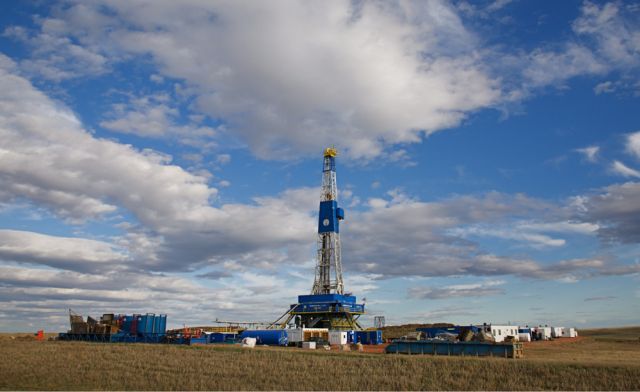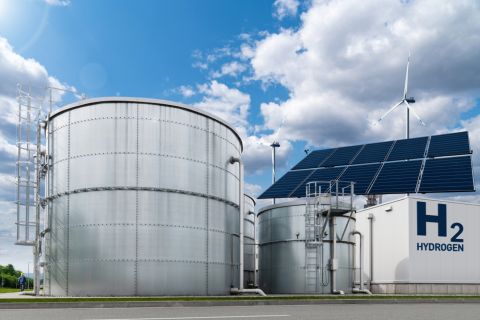
An oil rig is shown near Williston, North Dakota. (Source: Tom Reichner/ Shutterstock)
Decline rates and productivity, cost cutting and access to capital are among the concerns U.S. shale players may find themselves grappling with as they adjust business models amid commodity price uncertainty, analysts say.
The challenges come as the industry works to handle the consequences of a pandemic that has ravaged energy demand as supplies remain abundant, oil prices remain low and the world moves toward cleaner forms of energy. Transformational change may be on the horizon for the shale business in the U.S., where oil production has fallen from nearly 13 million barrels per day (MMbbl/d) earlier this year.
Oil production from the main U.S. shale plays was forecast by the Energy Information Administration to drop by 68,000 bbl/d in October to about 7.6 MMbbl/d.
“Shale is a mature business. In 2005, it was really about the shale revolution. Today, it’s about shale evolution, and a big part of that is that a lot of these basins are reaching maturation,” Matt Portillo, managing director of upstream research for Tudor, Pickering, Holt & Co. (TPH), said on a recent webinar by Rice University’s Baker Institute on shale’s future.
Looking at the Bakken, one of the more mature oil plays in the U.S., Portillo said TPH forecasts the play has only six to seven years’ worth of Tier 1 inventory left to develop. He called those wells “barely economic” at today’s commodity prices.
“The real question…is what oil prices do producers need to generate a healthy and sustainable business model while at least maintaining production and potentially over the medium term, driving very minimal amounts of growth,” Portillo said.
Oil prices had stabilized around $40/bbl but were down slightly Sept. 14 as rising cases of coronavirus continued to threaten demand. OPEC said world oil demand could fall to about 9.5 MMbbl/d in 2020. The organization also revised down its forecast for next year.
Some E&Ps, including EOG Resources, are vowing to stay disciplined.
RELATED: EOG Commits to ‘Staying Disciplined’ amid Market Uncertainty
“We are not interested in growing oil in an oversupplied market,” Bill Thomas, the company’s president and CEO, said Sept. 9 during the virtual Barclays CEO Energy-Power Conference.
Limited growth: Most companies are now only investing 70% to 80% of their cash flow, regardless of the commodity price cycle, according to Portillo. “E&Ps are committing, regardless of the upside in the commodity, to effectively capping their growth rate at a 5% level going forward, which is going to have profound implications on the U.S,” he said. “If you look at our macro model in 2021 for the U.S., we expect essentially the entire industry to move towards a maintenance capital scenario in a $40 to $45 commodity price environment, which is essentially holding production flat, exit to exit.”
With more consolidation in the industry, focus is expected to shift from growth to free cash flow generation. TPH forecasts U.S. production will grow only about 300,000 to 400,000 bbl/d on average from 2022 to 2025.

Cost, ESG Concerns: Mark Finley, fellow in energy and global oil at the Baker Institute’s Center for Energy Center, described oil companies’ access to capital as “brutal,” noting the sector’s share in the U.S. stock market dropped to a record low and there are ESG pressures.
“Energy is not the flavor of the month,” Finley said.
RELATED: Exxon Mobil Replaced by Software Stock on Dow Jones Industrial Index
On the cost front, there is not much left to trim and oilfield service companies “have already been squeezed,” he said. Plus, “technology has matured. The pace of learning is not as great as it was five years ago.”
Finley pointed out, however, per well productivity in the main U.S. shale plays grew by 10%, according to Department of Energy data. Further improvement from lower activity levels are expected, he added, noting “we’re left with the best crews, the best rigs, the best frac spreads and working only the best prospects.”
It’s unlikely, however, that such productivity gains will resemble the double and triple gains seen with the last downturn, Finley said.
Decline rate: Though most of the wells that U.S. producers shut in earlier this year are back online, the underlying decline rate has gotten bigger, Finley said.
“Heading into the crisis, it was well over 500,000 barrels a day every month. And as a result, today’s weekly estimate of U.S. production from the U.S. Energy Department shows crude production right now is 3 million barrels a day below pre-pandemic levels,” Finley said.
Portillo also spoke about the depletion of core inventory in the U.S. Accelerating the drillbit could translate to pulling down an inventory profile by five or six years, he said.
“If you get into that situation, you either have to start to drill Tier 2 rock, which tends to have a cost structure that’s $10 to $20 higher than your break evens on your Tier 1 rock or you’re going to have to go out and be more acquisitive again,” Portillo said. “And so, there is little public incentive, given the equity performance today, to go out and grow.”
Consolidation: Energy industry experts seem to agree that consolidation is needed and likely to happen in the U.S. shale space. Although deal activity has been sparse, analysts believe consolidation is imminent.
“There’s a very good chance that we see industry consolidation take down 60% to 80% of the companies that we think about from a coverage standpoint,” Portillo said.
Most believe each major play in the U.S.—excluding the Permian Basin and perhaps the Marcellus—needs only one or two champions, Portillo said, with mergers or equals being the correct formula for public companies.
“Those basins are at the point where they’re actually peaking on maturation and potentially rolling over. And in that world, it’s all about cost and scale going forward,” he said, later adding “the market cap of a lot of these companies has faded to a point where they’re just not relevant.”
TPH believes the number of public companies left in the sector will fall to between 10 and 15 larger companies with perhaps up to five small- and mid-cap E&Ps with exposure in different basins. “Beyond that, we just don’t see an investor appetite or public equity interest in really capitalizing companies beyond those levels.”
Recommended Reading
Kraft Heinz, Carlton Power Partner to Develop Green Hydrogen Plant
2024-02-05 - Located at Kraft Heinz’s Kitt Green manufacturing plant in Wigan, Greater Manchester, the proposed $50.1 million plant will have a 20-megawatt capacity.
Summit Carbon Solutions, POET Partner on CCS Project
2024-02-07 - The partnership will incorporate POET’s 12 facilities in Iowa and five facilities in South Dakota into Summit’s carbon capture and storage project.
Enough! Consumers Say They’re Overserved on Energy Transition, EY Finds
2024-02-11 - Two thirds of energy consumers are unwilling to spend more time and money to be sustainable, Ernst & Young reported.
Bunge, Chevron Announce FID on Oilseed Processing Plant
2024-03-05 - Bunge Chevron Ag Renewables' facility will be used to manufacture low carbon renewable fuels from oilseed.
Trace Carbon Solutions Applies for First Phase of Class VI Wells at Evergreen Hub
2024-03-12 - Trace is applying for its subsidiary Evergreen Sequestration Hub to be allowed to permanently sequester CO2 in underground geological formations in Louisiana.






